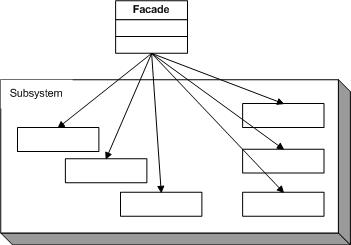PHP设计模式笔记:使用PHP实现门面模式
【意图】
为子系统中的一组接口提供一个一致的界面,Facade模式定义了一个高层次的接口,使得子系统更加容易使用【GOF95】
外部与子系统的通信是通过一个门面(Facade)对象进行。
【门面模式结构图】
【门面模式中主要角色】
门面(Facade)角色:
此角色将被客户端调用
知道哪些子系统负责处理请求
将用户的请求指派给适当的子系统
子系统(subsystem)角色:
实现子系统的功能
处理由Facade对象指派的任务
没有Facade的相关信息,可以被客户端直接调用
可以同时有一个或多个子系统,每个子系统都不是一个单独的类,而一个类的集合。每个子系统都可以被客户端直接调用,或者被门面角色调用。子系统并知道门面模式的存在,对于子系统而言,门面仅仅是另一个客户端。
【门面模式的优点】
1、它对客户屏蔽了子系统组件,因而减少了客户处理的对象的数目并使得子系统使用起来更加方便
2、实现了子系统与客户之间的松耦合关系
3、如果应用需要,它并不限制它们使用子系统类。因此可以在系统易用性与能用性之间加以选择
【门面模式适用场景】
1、为一些复杂的子系统提供一组接口
2、提高子系统的独立性
3、在层次化结构中,可以使用门面模式定义系统的每一层的接口
【门面模式与其它模式】
抽象工厂模式(abstract factory模式):Abstract Factory模式可以与Facade模式一起使用以提供一个接口,这一接口可用来以一种子系统独立的方式创建子系统对象。Abstract Factory模式也可以代替Facade模式隐藏那些与平台相关的类
调停者模式:Mediator模式与Facade模式的相似之处是,它抽象了一些已有类的功能。然而,Mediator目的是对同事之间的任意通讯进行抽象,通常集中不属于任何单个对象的功能。Mediator的同事对象知道中介者并与它通信,而不是直接与其他同类对象通信。相对而言,Facade模式仅对子系统对象的接口进行抽象,从而使它们更容易使用;它并定义不功能,子系统也不知道facade的存在
单例模式(singleton模式):一般来说,仅需要一个Facade对象,因此Facade对象通常属于Singleton对象。
【门面模式PHP示例】
1 2 3 4 5 6 7 8 9 10 11 12 13 14 15 16 17 18 19 20 21 22 23 24 25 26 27 28 29 30 31 32 33 34 35 36 37 38 39 40 41 42 43 44 45 46 47 48 49 50 51 52 53 54 55 56 57 58 59 60 61 62 63 64 65 66 67 68 69 70 71 72 73 74 75 76 77 78 79 80 81 82 83 84 85 86 87 88 89 90 91 92 93 94 95 96 97 98 99 100 101 102 103 104 105 106 107 108 109 110 111 112 113 114 115 116 117 118 119 120 121 122 123 124 125 126 127 128 129 130 131 132 133 134 135 136 137 138 139 140 141 142 143 144 145 146 147 148 149 150 151 152 153 154 155 156 157 158 159 160 161 162 163 164 165 166 167 168 169 170 171 172 173 174 175 176 177 178 179 180 181 182 183 184 185 186 | <?php /** * 门面模式 2010-06-12 sz * 《Java与模式》上门面模式示例的PHP版本 * @author phppan.p#gmail.com http://www.phppan.com * 哥学社成员(http://www.blog-brother.com/) * @package design pattern */ class Camera { /** * 打开录像机 */ public function turnOn() { echo 'Turning on the camera.<br />'; } /** * 关闭录像机 */ public function turnOff() { echo 'Turning off the camera.<br />'; } /** * 转到录像机 * @param <type> $degrees */ public function rotate($degrees) { echo 'rotating the camera by ', $degrees, ' degrees.<br />'; } } class Light { /** * 开灯 */ public function turnOn() { echo 'Turning on the light.<br />'; } /** * 关灯 */ public function turnOff() { echo 'Turning off the light.<br />'; } /** * 换灯泡 */ public function changeBulb() { echo 'changing the light-bulb.<br />'; } } class Sensor { /** * 启动感应器 */ public function activate() { echo 'Activating the sensor.<br />'; } /** * 关闭感应器 */ public function deactivate() { echo 'Deactivating the sensor.<br />'; } /** * 触发感应器 */ public function trigger() { echo 'The sensor has been trigged.<br />'; } } class Alarm { /** * 启动警报器 */ public function activate() { echo 'Activating the alarm.<br />'; } /** * 关闭警报器 */ public function deactivate() { echo 'Deactivating the alarm.<br />'; } /** * 拉响警报器 */ public function ring() { echo 'Ring the alarm.<br />'; } /** * 停掉警报器 */ public function stopRing() { echo 'Stop the alarm.<br />'; } } /** * 门面类 */ class SecurityFacade { /* 录像机 */ private $_camera1, $_camera2; /* 灯 */ private $_light1, $_light2, $_light3; /* 感应器 */ private $_sensor; /* 警报器 */ private $_alarm; public function __construct() { $this->_camera1 = new Camera(); $this->_camera2 = new Camera(); $this->_light1 = new Light(); $this->_light2 = new Light(); $this->_light3 = new Light(); $this->_sensor = new Sensor(); $this->_alarm = new Alarm(); } public function activate() { $this->_camera1->turnOn(); $this->_camera2->turnOn(); $this->_light1->turnOn(); $this->_light2->turnOn(); $this->_light3->turnOn(); $this->_sensor->activate(); $this->_alarm->activate(); } public function deactivate() { $this->_camera1->turnOff(); $this->_camera2->turnOff(); $this->_light1->turnOff(); $this->_light2->turnOff(); $this->_light3->turnOff(); $this->_sensor->deactivate(); $this->_alarm->deactivate(); } } /** * 客户端 */ class Client { private static $_security; /** * Main program. */ public static function main() { self::$_security = new SecurityFacade(); self::$_security->activate(); } } Client::main(); ?> |

Pingback引用通告: PHP内核中的对象管理机制 | PHP源码阅读,PHP设计模式,PHP学习笔记-胖胖的空间